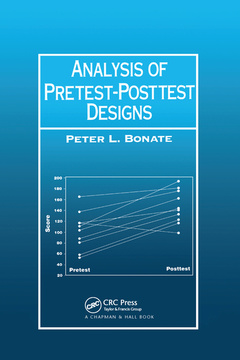Description
Analysis of Pretest-Posttest Designs
Author: Bonate Peter L.
Language: English
Subjects for Analysis of Pretest-Posttest Designs:
Keywords
Posttest Scores; Pretest Scores; difference; Percent Change Scores; scores; Pretest Posttest Data; data; Difference Scores; Pretest Posttest Designs; hypothesis; Test Retest Correlation; percent; ANOVA Table; change; SAS Code; measurements; Null Hypothesis; correlation; Posttest Measurements; baseline; Pe Rc; RBD; Data Set; Spearman Rank Correlation Coefficient; ANOVA Method; Conditional Expectation; Source DF Sum; ANCOVA Method; Baseline Score; Statistical Test; Randomization Tests; Permutation Tests; Proc IML; Bisquare Function
Publication date: 06-2020
· 15.6x23.4 cm · Paperback
Publication date: 05-2000
224 p. · 15.6x23.4 cm · Hardback
Description
/li>Contents
/li>Readership
/li>Biography
/li>
How do you analyze pretest-posttest data? Difference scores? Percent change scores? ANOVA? In medical, psychological, sociological, and educational studies, researchers often design experiments in which they collect baseline (pretest) data prior to randomization. However, they often find it difficult to decide which method of statistical analysis is most appropriate to use. Until now, consulting the available literature would prove a long and arduous task, with papers sparsely scattered throughout journals and textbook references few and far between.
Analysis of Pretest-Posttest Designs brings welcome relief from this conundrum. This one-stop reference - written specifically for researchers - answers the questions and helps clear the confusion about analyzing pretest-posttest data. Keeping derivations to a minimum and offering real life examples from a range of disciplines, the author gathers and elucidates the concepts and techniques most useful for studies incorporating baseline data.
Understand the pros and cons of different methods - ANOVA, ANCOVA, percent change, difference scores, and more
Learn to choose the most appropriate statistical test - Numerous Monte Carlo simulations compare the various tests and help you select the one best suited to your data
Tackle more difficult analyses - The extensive SAS code included saves you programming time and effort
Requiring just a basic background in statistics and experimental design, this book incorporates most, if not all of the reference material that deals with pretest-posttest data. If you use baseline data in your studies, Analysis of Pretest-Posttest Designs will save you time, increase your understanding, and ultimately improve the interpretation and analysis of your data.
Peter L. Bonate




